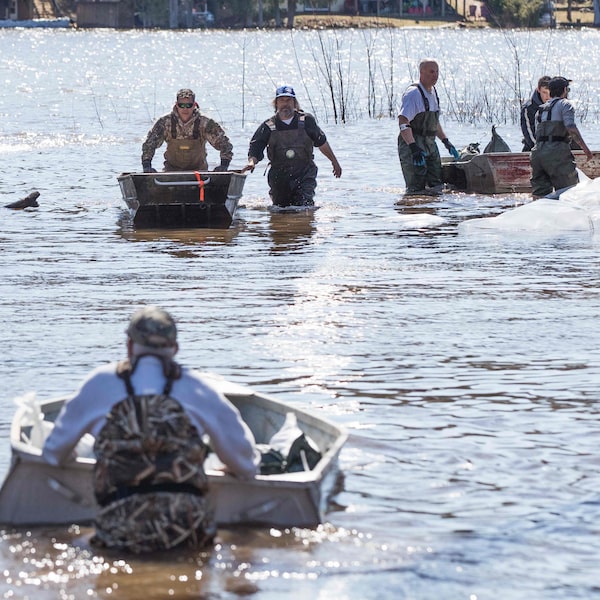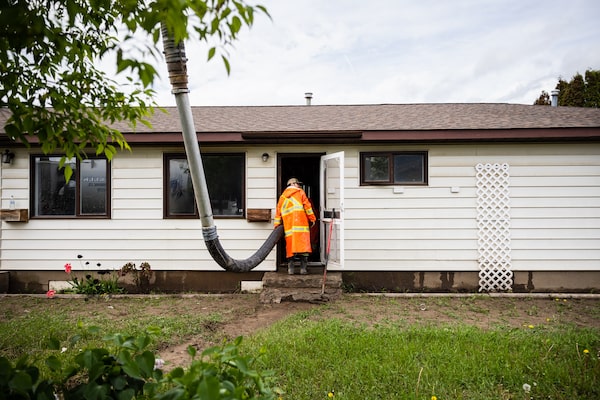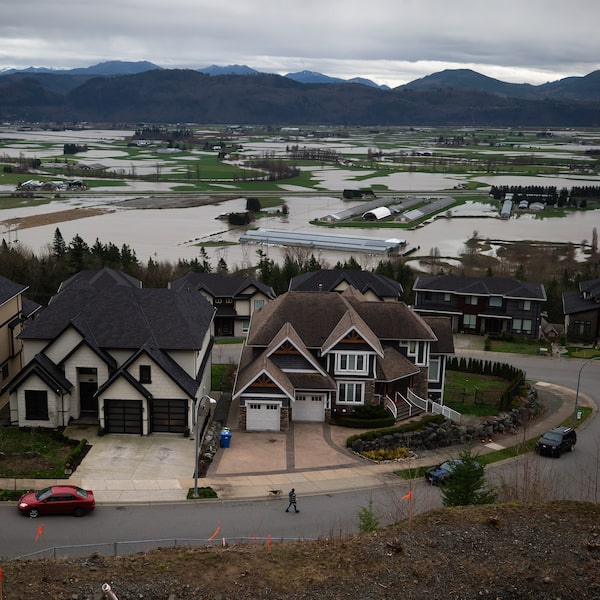:format(jpeg)/cloudfront-us-east-1.images.arcpublishing.com/tgam/CCNAVLRVRNGJTPPSR5RMNVRHQ4.jpg)
Janine Cooper travels daily from her temporary lodging outside Merritt, B.C., to her single-wide trailer in town to work at restoring her flood-damaged home. She is what the city’s mayor refers to as a climate refugee, displaced when the Coldwater River topped its banks last November in a one-in-one-thousand-year flood event. The entire town was evacuated at the time, and many homes remain uninhabitable.
Ms. Cooper fled her home in the middle of the night on Nov. 15. Amid the din of children screaming and the roar of the river, she only had time to grab a litter of puppies, dog food and her husband’s ashes. When she was finally allowed to return in February, her home was filled with a thick layer of frozen mud. She needed an axe to clear a path inside. Few of her belongings survived, but she was among the more fortunate: Three of her neighbours’ homes washed down the river.
She wants to move back permanently, but the decision is not hers alone. Merritt is wrestling with a question that some other Canadian communities have already dealt with: Should it rebuild as before, or pull back from the water’s edge?

Volunteers help with sandbags in Constance Bay, Ont., after spring floods in 2019.LARS HAGBERG/AFP/Getty Images
Constance Bay in Ontario was rebuilt after massive flooding of the Ottawa River in 2017. In 2019, the community was flooded again. And rebuilt. This May, hundreds of residents were asked to evacuate when flooding returned once more.
Just 30 kilometres away, across the river, many residents of Pointe-Gatineau, Que., opted to accept provincial government buyouts to relocate after the 2019 floods. But some homeowners remain, and they were also at risk in the spring.
Later this year, the federal government will present its strategy for climate adaptation, and managed retreat will play a role.
The effects of climate change are increasing in frequency, severity – and cost. Ottawa’s disaster relief payments are spiralling, and it hopes that strategic investments to improve resiliency in at-risk communities will save money in the long run. A report prepared for Natural Resources Canada in 2020 concluded that the full cost of “persisting in place, with rebuilding accommodations, is double or more the cost of retreat.”
But it isn’t always an easy sell, and can be hard to do well.
Merritt Mayor Linda Brown doesn’t relish the tough choices ahead. The city was established 130 years ago as a ranching community at the confluence of the Coldwater and Nicola rivers. The abundant water supply for cattle made sense then. Now the community is exposed to the risks of a changing climate.
“A lot of individuals do not want to put their head down next to the river, wondering if it’s going to do the same thing over the next little while, or whether they’re going to be safe,” Ms. Brown said. “And we can’t give them that assurance.”
:format(jpeg)/cloudfront-us-east-1.images.arcpublishing.com/tgam/PAOYPM4KJFIZFE2URJUGNZNSPE.JPG)
:format(jpeg)/cloudfront-us-east-1.images.arcpublishing.com/tgam/BF7YB2AKVBAERJAIFRCB7ZVXDI.jpg)

Workers vacuum out a small apartment complex. River mud and ice caused widespread damage, and later mould, in many properties.Melissa Tait/The Globe and Mail
Canada’s Minister of Emergency Preparedness, Bill Blair, visited Merritt this spring to talk to people living with the uncertainty of whether they can, or should, rebuild their homes.
“Everywhere I go, I see the local officials and people who’ve been impacted by these events. And it’s very clear that there has been a number of communities that have been built in areas that are high risk – and the risk is changing as well,” he said in an interview.
“What used to be 100-year flooding events have been far more frequent.”
The federal government is working to produce better flood mapping, and he says bluntly what some local politicians are loath to say: “Frankly, it doesn’t make a lot of sense to rebuild in an area that is at high risk of future disaster events. And so we want to make sure that people can make informed decisions.”
In 2013, Alberta experienced the most destructive flood in its recorded history. In the community of High River, more than 80 per cent of homes were inundated.
Today, the town bills itself as one of the most flood-protected communities in North America. Part of the solution was better flood mitigation works, but two neighbourhoods were also removed from the floodplain.
Debris is piled in the lot behind a vacant apartment building in High River, Alta., after floods in 2013.Kevin Van Paassen/The Globe and Mail
Craig Snodgrass led the retreat. He is serving his third term as mayor of High River. To update his portrait for city hall, he chose as a backdrop the greenspace where estate homes once overlooked the Highwood River.
The transformation of the former Beachwood estates and Wallaceville, one of the town’s oldest neighbourhoods, back to the natural floodplain habitat is a symbol of his work.
“Now there are walking paths, mountain bikers, people walking their dogs – it’s just a nature area, it’s a great massive addition to our greenspace,” Mr. Snodgrass said. “There are always people pressuring to build – they forget about the flooding real quick. But we have been firm, nothing is going back in there.”
Local governments need to bear some responsibility for allowing developments in the first place, he said. “We crawl up the ass of the river, and then scratch our heads wondering why our basements are full of water.”
Quebec has relied on buyouts as part of its disaster recovery plan. In 2019, Quebec Premier François Legault urged homeowners in floodplains not to rebuild, offering up to $200,000 each to move instead. Although the buyouts for properties at risk of repeated overland flooding are voluntary, the province dangles a stick: It has set a lifetime limit on disaster aid and bans rebuilding in designated flood zones.
Many residents in Pointe-Gatineau accepted the buyout. More than 200 properties have been transferred to the city, or are in the process of being transferred. When the community faced a flood warning again in late May, far fewer homes were in the danger zone. But 163 buildings and 508 people were still at risk.

A boy walks along flooded streets in Gatineau, Que., during the floods of 2019. Thanks to a buyout, there are now fewer occupied homes in the Pointe-Gatineau neighbourhoods most at risk of flooding.Justin Tang/The Canadian Press
In Alberta, Mayor Snodgrass acknowledges that relocation can be a tough sell. Telling the residents of Wallaceville and Beachwood that they would have to take a buyout was the low point of his political career.
“I never want to be in a meeting like that again,” he said. “I had families crying at the table. ... But it was an honest decision, we didn’t put any butterflies around it.”
Trying to make decisions in response to a disaster is especially tough. People are struggling with the ordeals that forced them out – and it can take a year or more before different levels of government can come up with the cash and planning needed.
As the months go by, however, it gets more difficult to tell people to abandon their efforts to go home.
Ms. Cooper has been scrubbing her way to recovery, slowly assembling a kitchen out of salvaged cupboards and counters, a used fridge and stove, and some new wallpaper. But there is no plumbing yet and her beloved garden has been reduced to a tiny patch of daylilies that emerged out of the mud in May.
“It’s still nice here. I don’t think we are going to get hit again. And now I’ve got a new kitchen,” she said. “I’m doing all this work, I’m not moving. It’s my home.” She did consider walking away, but it would be too expensive. She had no insurance, and lives on a small pension. “I can’t afford rent.”
Teri McMillan is also waiting for power and water to be returned to the trailer park. She has exhausted her finances trying to fix up her home since November, and when the spring freshet threatened another flood, she was constantly checking the river. “I’m crossing my fingers, hoping and praying it won’t happen again,” she said. “I don’t necessarily want to stay. I can’t afford to leave.”
:format(jpeg)/cloudfront-us-east-1.images.arcpublishing.com/tgam/O3RN2IJ2AZHKXCP3JWJEVNNQXM.jpg)
:format(jpeg)/cloudfront-us-east-1.images.arcpublishing.com/tgam/YRQCYWIVOBAY7MX5Y25MLYWFBM.jpg)
:format(jpeg)/cloudfront-us-east-1.images.arcpublishing.com/tgam/JKQ2HULX3BFVZLK3Z6MXPFVM6E.jpg)
Merritt’s existing floodplain maps show that much of the city is built where the Nicola River is inclined to flood. Mike Goetz’s home on the Coldwater River, where he has lived for 27 years, should have been safe – but it wasn’t. Last summer’s wildfires were among the worst on record in B.C., and consumed some of the forests around the valley. The charred land couldn’t absorb November’s heavy rains.
“It’s very easy to see global warming,” he said. “I wasn’t on the floodplain, but now it is a floodplain.”
Mr. Goetz and his wife have restored their home. They debated whether to sell it and move, but the flood brought a different kind of tragedy for his family, leaving him indifferent to the risk. During the evacuation, his daughter was in a vehicle accident while relocating her family, and his six-year-old granddaughter died. “If we had another flood, it wouldn’t matter to me,” he said. “What we lost was unimaginable.”
Two months after Merritt’s evacuation, Mayor Brown had an idea of what was required. “There’s approximately 100 houses that will never be in a position to rebuild where they are,” she said in an interview in January.
But while these traumas are fresh, it’s hard to engage the community in the kind of conversation that Merritt’s 7,000 residents need to have about the future. City council has commissioned a study, due this summer, that will map out some options for dikes and/or retreat. Once that is done, the dialogue can start, Ms. Brown said. “It depends on the type of diking system we get engineered, to determine how many metres we need to be away from the river. In the meantime, this is creating a lot of anxiety for our citizens.”

Forest-fire damage reaches the edge of the Coldwater River, where the remains of trees carried from the mountains are still scattered on the shore. Fires in the summer of 2021 primed the land around Merritt for flooding by making the soil less water-absorbant.Melissa Tait/The Globe and Mail
:format(jpeg)/cloudfront-us-east-1.images.arcpublishing.com/tgam/RDMRPRE3XZCMVMCOZR6G2VX2MA.jpg)
:format(jpeg)/cloudfront-us-east-1.images.arcpublishing.com/tgam/KKIPRZQ5WBDD7J5O4I4P4E4DCM.jpg)
Experts who spoke to The Globe and Mail agree on one thing: Communities that are at risk of natural disasters should be planning before a crisis hits.
In January, a report from the Expert Panel on Disaster Resilience in a Changing Climate observed that myopia gets in the way of good policy: People are reluctant to pay upfront for something that may never even happen. But the cost of preventing and preparing for disasters, they argue, is several times less than responding to and recovering from them. Especially since climate change is changing the frequency, severity and distribution of natural hazards.
Sophie Guilbault, director of partnerships at the Institute for Catastrophic Loss Reduction, said such plans should include funds to help vulnerable communities figure out whether retreat from flood risk is required. “I think we have reached a turning point. It’s very clear that these events will keep happening. So the investments that we make now will pay off – there is no doubt about that,” she said.
Armed with better floodplain maps and an understanding of the increasing danger, communities can avoid risk by banning construction in flood zones. But what to do about homes and infrastructure that are already built?
This is the challenge facing many local governments across Canada: They have inherited development in places that should never have been developed, and are under constant pressure to allow new construction where it ought not go.
“Never allowing construction on the floodplain is one thing, but reversing some of the bad decisions that were made,” Ms. Guilbault said, “it’s just something else.”
The solution is often mandatory buyouts to ensure a successful retreat, but homeowners need to be offered fair market value for their homes so that they can relocate without hardship, she added. “You have to have the political will to make the offers appealing.”

Flooded farmland lies behind a residential neighbourhood in Abbotsford, B.C., this past December.Darryl Dyck/The Canadian Press
Building bigger dikes – as Abbotsford’s city council proposed after billions of dollars worth of flood damage last November – can be an easier solution that avoids unhappy voters and the loss of taxable properties.
Human nature is a tough hurdle to clear, says Kees Lokman, a professor at the University of B.C.’s School of Architecture, and director of the UBC Coastal Adaptation Lab. “We’re stubborn, we don’t like change and we don’t want to change.”
In 2020, the Pacific Institute for Climate Solutions launched the Living with Water project under his direction. It aims to interrupt the “flood-rebuild-flood-rebuild” cycles seen in many communities. “The problem is that when we are reacting, we are on our back heels,” he said. “You’re often on the defence. If you are proactive, you can act with foresight.”
He suggests using different language to ease difficult conversations.
“The terminology is very, I would say, military and colonial and I think that it scares people, because ‘managed retreat’ sounds like you’re being defeated.” Talk instead about protecting each other and accommodating water, he said, and the conversation might at least begin.

Family albums dry out at the Nicoletteville ranch in Merritt last Nov. 24, after the floods.Artur Gajda/The Globe and Mail
Although advance planning is ideal, communities can tackle post-disaster retreat successfully, says geography professor Brent Doberstein, interim director of the University of Waterloo’s climate change programs. But it requires a lot of support for those who have been flooded out while the details are sorted.
“Think about it: You’ve just had a devastating flood to your house and now people are approaching you to offer a retreat program that’s going to take 18 months to go through. And during that time, you can’t live in your damaged house and you can’t go to a new house. So the retreat process is retraumatizing people.”
This spring, Prof. Doberstein visited the city of Grand Forks, B.C. After a major flood in 2018, 85 per cent of residents supported managed retreat, he noted, but by the time the funding from the provincial and federal governments was approved, many homeowners changed their mind.
“There’s a window of opportunity that disasters provide, but that’s not an unlimited window. It eventually closes. So I think the time to think about retreat, unfortunately for British Columbia, is now, and it may not be possible to think in the same way two years from now.”
The community of Merritt is still in that window, where residents are confronted with a decision about their future.
This year’s spring freshet brought fears of another flood, while people living higher up the slopes of the valley worry about the return of wildfires that came dangerously close last summer.
Mayor Brown worries that the solutions will be difficult, especially for those who remain where they are because they can’t afford to move.
“I’m not sure what the answer is,” Ms. Brown said. “I’m kind of worried, myself, about what the answer may be.”

The Coldwater flows past a section of exposed riverbed in Merritt.Melissa Tait/The Globe and Mail
This article is part of No Safe Place, a year-long Globe project on climate adaptation in the wake of a string of climate-related disasters in Western Canada.
Climate change: More from The Globe and Mail
The Decibel
While Canada waits for a federal strategy on climate adaptation, the oil-and-gas sector has work to do meeting the Trudeau government’s targets for reducing emissions by 42 per cent by 2030. Adam Radwanski explains what must be done. Subscribe for more episodes.
Continuing coverage
Subscribe to The Globe and Mail’s weekly climate newsletter for the latest updates. Digital subscribers can also select “follow” on our topic page to be notified of new stories.
On floods
What happens to your home’s value when your neighbourhood floods?
How Calgary’s massive flood project aims to tame the Elbow River
 Justine Hunter
Justine Hunter